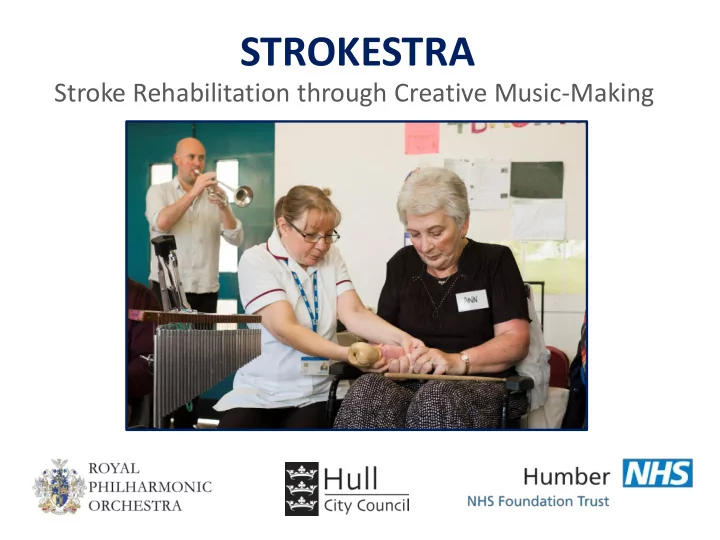

STROKESTRA Stroke Rehabilitation through Creative Music-Making
Evidence Base • Studies have focused on the use of music to promote social interaction, positive mood and lower depression and anxiety. Nayak et al., 2000; Barbara et al., 2003; Guetin, 2009; Kim, 2011; Poćwierz -Marciniak, 2014 • Listening to music has been found to have short term effects on visual awareness, visual attention and unilateral neglect . Sarkamo, et al., 2012; Rodriguez-Fornells, 2012; Mei Ching et al., 2013; Tsai, 2013 • Studies have concluded that music listening can improve auditory and verbal memory, attention and mood. Sarkamo, 2012
Evidence Base • A Cochrane review concluded that rhythmic auditory stimulation can be beneficial for improving gait parameters. Bradt et al., 2010 • Music has been shown to support upper limb recovery including improved fine and gross motor movements and self- management . Van Wijck, 2012; Altenmuller, 2009 • Listening to music can also support neuroplastic changes in chronic stroke patients. Amengual et al., 2013; Raghaven et al., 2014; Jamali et al., 2014
Research & Development
Structure • Patients identified by HICSS staff • Patients chose individualised goals to work towards • Patients assigned to AM or PM group • 4x monthly RPO-led sessions: two consecutive days • 4x interim HICSS-led sessions: one day • Patients given instruments and ‘homework’ to continue work between sessions • 1x RPO-led finale: 3 workshop days + 1 performance day
Schedule Dates Activity 28 & 29 May 2015 RPO Project 1 5 June RPO Musician Training 10 June HICSS Staff Training 11 & 12 June RPO Project 2 2 July HICSS Project 1 16 & 17 July RPO Project 3 30 July HICSS Project 2 13 August HICSS Project 3 20 & 21 August RPO Project 4 17 September HICSS Project 4 28, 29, 30 September & 1 October RPO Project 5 and Performance
Sessions
Sessions
Evaluation • Stroke Impact Scale – baseline and post-project • Specific goal related assessments (e.g. COAST, GAD-7, PHQ-9, Chedoke Upper Limb) • Post-project evaluation surveys with patients, carers and HICSS staff • Focus group with patients and carers • Focus group with RPO team
Results 100 90 80 70 60 50 40 30 20 10 0 Symptom Social benefit - Cognitive Emotional Physical relief - 86% 91% benefit - 86% benefit - 86% benefit - 71%
Results Stroke Impact Scale - % of patients Domain increasing by at least 10 points Physical Strength 33.3 Cognition 43.8 Mood 43.8 Communication 35.3 Activities 31.3 Mobility 18.8 Hand use 56.3 Participation 62.5
Results • 100% of carers reported an improvement in their own wellbeing and respite from their role as carer. • 100% of carers reported improved relationships with their patient as a result of participating alongside them. • HICSS staff reported gaining inspiration (80%), team morale (70%) and renewed relationships with patients (60%).
Testimonials ‘I feel I am walking so much better and want to do more now. I am also sleeping better which I feel is from relaxing me playing the music.’ – Patient ‘It made me feel I wasn’t the only one in my position. Caring can be a lonely path at times and you can feel sad.’ – Carer ‘I found this project inspiring and energising. It has re-ignited my own personal interest in music, which has helped my wellbeing, health and ultimately my work. It has made me re-evaluate how we work with patients and the priorities we have. ‘ – HICSS Staff
Lessons Learned • It took patients (and staff) time to settle into the sessions and begin taking advantage of the therapy opportunities. • Staff rotas are necessary to ensure staff can plan well in advance to fit in sessions around duties. • Musical execution can take precedence over therapy for patients, so it is important to keep reviewing goals. • There are opportunities for developing more techniques for specific goals, especially speech & language rehabilitation.
Legacy • HICSS staff are using musical techniques and instruments in one to one care, and beginning a drumming group. • Patients have purchased their own instruments including clarinet, guitar, and electric keyboard. • One patient has begun making cellos. • One patient has returned to calligraphy.
Future • Long-term programme to allow enough time for meaningful improvement • Incorporate more patients from rehabilitation units • Focus on progression into community groups and un- supported hobbies • Involve external evaluator(s) to enable more clinical baseline comparisons of all patients • Include further training for clinical staff and university partners to develop work force
Further Information Full evaluation report, programme guide, film and presentation slides are available on www.rpo.co.uk/strokestra RPO Community & Education Team rodiol@rpo.co.uk Hull Integrated Community Stroke Service Carolhargreaves@nhs.net Clarenicholson1@nhs.net Michelle.wilson5@nhs.net
Recommend
More recommend